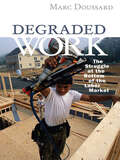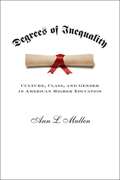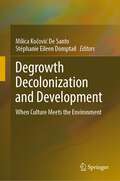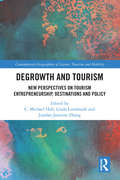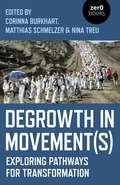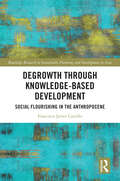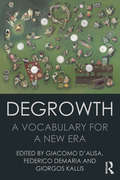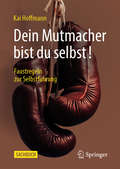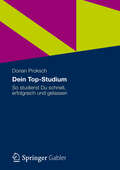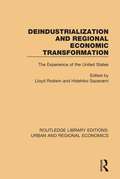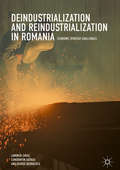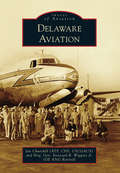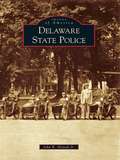- Table View
- List View
Degraded Work: The Struggle at the Bottom of the Labor Market
by Marc DoussardCritics on the left and the right typically agree that globalization, the loss of manufacturing jobs, and the expansion of the service sector have led to income inequality and rising numbers of low-paying jobs with poor working conditions. In Degraded Work, Marc Doussard demonstrates that this decline in wages and working conditions is anything but the unavoidable result of competitive economic forces. Rather, he makes the case that service sector and other local-serving employers have boosted profit with innovative practices to exploit workers, demeaning their jobs in new ways—denying safety equipment, fining workers for taking scheduled breaks, requiring unpaid overtime—that go far beyond wage cuts. Doussard asserts that the degradation of service work is a choice rather than an inevitability, and he outlines concrete steps that can be taken to help establish a fairer postindustrial labor market. Drawing on fieldwork in Chicago, Degraded Work examines changes in two industries in which inferior job quality is assumed to be intrinsic: residential construction and food retail. In both cases, Doussard shows how employers degraded working conditions as part of a successful and intricate strategy to increase profits. Arguing that a growing service sector does not have to mean growing inequality, Doussard proposes creative policy and organizing opportunities that workers and advocates can use to improve job quality despite the overwhelming barriers to national political action.
Degrees Of Inequality: Culture, Class, And Gender In American Higher Education
by Ann MullenDegrees of Inequality reveals the powerful patterns of social inequality in American higher education by analyzing how the social background of students shapes nearly every facet of the college experience. <p><p> Even as the most prestigious institutions claim to open their doors to students from diverse backgrounds, class disparities remain. Just two miles apart stand two institutions that represent the stark class contrast in American higher education. Yale, an elite Ivy League university, boasts accomplished alumni, including national and world leaders in business and politics. Southern Connecticut State University graduates mostly commuter students seeking credential degrees in fields with good job prospects. <p> Ann L. Mullen interviewed students from both universities and found that their college choices and experiences were strongly linked to social background and gender. Yale students, most having generations of family members with college degrees, are encouraged to approach their college years as an opportunity for intellectual and personal enrichment. Southern students, however, perceive a college degree as a path to a better career, and many work full- or part-time jobs to help fund their education. <p> Moving interviews with 100 students at the two institutions highlight how American higher education reinforces the same inequities it has been aiming to transcend.
Degrowth Decolonization and Development: When Culture Meets the Environment
by Milica Kočović De Santo Stéphanie Eileen DomptailDegrowth Decolonization and Development reveals common underlying cultural roots to the multiple current crises. It shows that culture is an essential sphere to initiate fundamental changes and solutions as it brings about transformative imaginaries on a theoretical, political and practical level. The book focusses on the interplay between culture and the environment, society and the economy. It provides a critique of concepts associated with the term “Development” and reveals knowledge and theories outside the comfort zone of the mainstream Western theoretical landscape, which will certainly be instrumental in the decolonization of both development theories and practices. The book convincingly reveals the large array of domains, which, when interpreted from a decolonization and Degrowth perspective, can be managed through logics of environmental justice, social equity and equality, and generate societally more desirable outcomes. The book presents a multidisciplinary perspective on the contemporary global crises and features interdisciplinary analyses thereof through the lenses of cultural studies, critical development studies, political economy, eco-feminist political ecology, anthropology and sociology. Degrowth Decolonization and Development unveils the fundamental role of the dichotomies characterizing the Western modern development paradigm in shaping today’s actions, and especially the dichotomies of Global North and Global South, Centre and Periphery, Developed and Developing/Underdeveloped, Man and Nature. Degrowth Decolonization and Development addresses all researchers and activists interested in sustainability transformation and decolonization processes in Development studies. Degrowth Decolonization and Development is structured as a collection of seven original case studies. These are authored by researchers who met when presenting their work in Decolonization and Degrowth panels from the ISEE-ESEE-Degrowth Conference, Manchester, July 5-8, 2021, and the 8th International Degrowth Conference in The Hague, Netherlands, August 24-28, 2021. The concluding chapter proposes a synthesis identifying key concepts and steps in cultural change for the decolonization of the Western worldview towards “pluriverse” alternatives. The book traces future imaginaries for modelling future new systemic solutions and a needed radical change.
Degrowth and Tourism: New Perspectives on Tourism Entrepreneurship, Destinations and Policy (Contemporary Geographies of Leisure, Tourism and Mobility)
by C. Michael Hall; Linda Lundmark; Jundan Jasmine ZhangThe sustainability of tourism is increasingly under question given the challenges of overtourism, COVID-19 and the contribution of tourism to climate and environmental change. Degrowth and Tourism provides an original response to the central problem of growth in tourism, an imperative that has been intrinsic within tourism practice, and directs the reader to rethink the impacts of tourism and possible alternatives beyond the sustainable growth discourse. Using a multi-scaled approach to investigate degrowth’s macro effects and micro indications in tourism, this book frames degrowth in tourism in terms of business, destination and policy initiatives. It uses a combination of empirical research, case studies and theory to offer new perspectives and approaches to analyse issues related to overtourism, COVID-19, small-scale tourism operations and entrepreneurship, mobility and climate change in tourism. Interdisciplinary chapters provide studies on animal-based tourism, nature-based tourism, domestic tourism, developing community-centric tourism and many other areas, within the paradigm of degrowth. This book offers significant insight on both the implications of degrowth paradigm in tourism studies and practices, as well as tourism’s potential contributions to the degrowth paradigm, and will be essential reading for all those interested in sustainable tourism and transformations through tourism.
Degrowth in Movement(s): Exploring Pathways for Transformation
by Matthias Schmelzer Nina Treu Corinna BurkhartDegrowth is an emerging social movement that overlaps with proposals for systemic change such as anti-globalization and climate justice, commons and transition towns, basic income and Buen Vivir. Degrowth in Movement(s) reflects on the current situation of social movements aiming at overcoming capitalism, industrialism and domination. The essays ask: What is the key idea of the respective movement? Who is active? What is the relation with the degrowth movement? What can the degrowth movement learn from these other movements and the other way around? Which common proposals, but also which contradictions, oppositions and tensions exist? And what alliances could be possible for broader systemic transformations? Corinna Bukhart, Matthias Schmelzer, and Nina Treu have curated an impressive demonstration that there are, beyond regressive neoliberalism and techno-fixes, emancipatory alternatives contributing to a good life for all. Degrowth in Movement(s) explores this mosaic for social-ecological transformation - an alliance strengthened by diversity.
Degrowth in Tourism: Conceptual, Theoretical And Philosophical Issues
by Konstantinos AndriotisThe modern-day world faces a hostile climate, depleted resources and the destruction of habitats. The dream that growth will lead to a materialistic utopia is left unfulfilled by a lack of ecological and economic capacity. The only choice is to find alternatives to increased growth, transform the structures and institutions currently shaping the world, change lifestyles and articulate a more credible vision for the future and lasting prosperity. As a reaction to the problems accrued by capitalism, new development approaches such as the concept of degrowth have evolved. <P><P>Degrowth in Tourism explores newly-emerging development and philosophical approaches that provide more equity for host communities and offer a low-carbon future by looking at alternatives to the classic models of development and applying the concept of degrowth in a tourism context. <P><P>Proposing that we need to shift tourism research from models which prioritize commodified tourism experiences to those that offer alternative decommodified ones, this book: <P><P>- Provides topical analysis and illustrates the key themes of degrowth; - Discusses the relationship between tourism and degrowth from both a historic perspective and through contemporary patterns of activity; - Includes international examples and case studies to translate theory into practical new approaches. <P><P>A comprehensive review of the subject, this book will be of great interest to researchers and practitioners within tourism, development, environment and economics, as well as those specifically studying degrowth.
Degrowth in Tourism: Conceptual, Theoretical and Philosophical Issues
by Dr Konstantinos AndriotisThe modern-day world faces a hostile climate, depleted resources and the destruction of habitats. The dream that growth will lead to a materialistic utopia is left unfulfilled by a lack of ecological and economic capacity. The only choice is to find alternatives to increased growth, transform the structures and institutions currently shaping the world, change lifestyles and articulate a more credible vision for the future and lasting prosperity. As a reaction to the problems accrued by capitalism, new development approaches such as the concept of degrowth have evolved. Degrowth in Tourism explores newly-emerging development and philosophical approachesthat provide more equity for host communities and offer a low-carbon future by looking at alternatives to the classic models of development and applying the concept of degrowth in a tourism context. Proposing that we need to shift tourism research from models which prioritize commodified tourism experiences to those that offer alternative decommodified ones, this book: - Provides topical analysis and illustrates the key themes of degrowth; - Discusses the relationship between tourism and degrowth from both a historic perspective and through contemporary patterns of activity; - Includes international examples and case studies to translate theory into practical new approaches. A comprehensive review of the subject, this book will be of great interest to researchers and practitioners within tourism, development, environment and economics, as well as those specifically studying degrowth.
Degrowth through Knowledge-Based Development: Social Flourishing in the Anthropocene (Routledge Research in Sustainable Planning and Development in Asia)
by Francisco Javier CarrilloThis book tackles the terms under which a knowledge-based society can indefinitely improve while pursuing an eco-economic steady state. In doing so, it addresses the literature gap on continued social improvement within a post-growth economic and cultural paradigm.Carrillo consolidates research on the Degrowth paradigm and proposes a conceptual framework for continued social improvement based on the integration of tangible and intangible collective values. He proposes a method that accounts for effective social value through capital systems valuation and development and includes this operational metric system as an alternative to the metric of Gross National Product (GNP). The book critically examines the challenges of identifying a complete and consistent representation of total social value. The book also includes a series of knowledge-based development programmes in cities and regions around the world and discusses policies and practices for urban mitigation and adaptation to the Anthropocene.This transdisciplinary book will be of particular interest to researchers of degrowth economics, sustainable development, and urban planning.
Degrowth, Depth and Hope in Sustainable Business: Reflections from Denmark, Finland and Sweden (Routledge Research in Sustainability and Business)
by Iana NesterovaThis book takes degrowth theorising in the direction of honouring collaboration, creating new dialogues and emphasising growth and human capacities. Traditionally, degrowth theorising has focussed on reduction and non‑growth. While the ecological concerns of degrowth scholarship are felt acutely by many, the suggestion of “less” can be experienced as undesirable, going against who we are as humans, and even be false in some industries and spaces. Indeed, for a degrowth society to come into being, unprecedented (though not materialistic) growth is needed. This book unpicks the business and sustainability framework rooted in degrowth scholarship and proposes a gentler approach to business for a sustainable society living harmoniously with nature. Drawing on case studies from Finland, Sweden and Denmark, Iana Nesterova reflects on how degrowth manifests in imperfect and nuanced ways and examines the ways in which businesses navigate creatively and cautiously challenging socio‑economic landscapes, and why they do this. She puts forward a new framework for growth within degrowth, centred around humanism and hope, which celebrates empathy, care, solidarity and connectedness with human and non‑human others and nature. Presenting an empowering and liberating view on sustainable business, this book will be of great interest to students and scholars of business ethics, ecological economics, business organisation and management.
Degrowth: A Vocabulary for a New Era (The\economy: Key Ideas Ser.)
by Giacomo D'Alisa Federico Demaria Giorgos KallisDegrowth is a rejection of the illusion of growth and a call to repoliticize the public debate colonized by the idiom of economism. It is a project advocating the democratically-led shrinking of production and consumption with the aim of achieving social justice and ecological sustainability. This overview of degrowth offers a comprehensive coverage of the main topics and major challenges of degrowth in a succinct, simple and accessible manner. In addition, it offers a set of keywords useful forintervening in current political debates and for bringing about concrete degrowth-inspired proposals at different levels - local, national and global. The result is the most comprehensive coverage of the topic of degrowth in English and serves as the definitive international reference. More information at: vocabulary.degrowth.org View the author spotlight featuring events and press related to degrowth at http://t.co/k9qbQpyuYp.
Dein Mutmacher bist du selbst!: Faustregeln zur Selbstführung
by Kai HoffmannMut ist die fundamentale Antriebskraft, damit wir im Leben das erreichen, was wir wirklich wollen. Um mutig und erfolgreich handeln zu können, benötigen wir Metaphern einer mutigen Selbsterzählung. Denn in jedem Augenblick unseres Lebens handeln wir nach Geschichten, die wir uns selbst erzählen – so der Managementberater und Coach Kai Hoffmann. Eine fundierte, klar strukturierte und spannende Anleitung für das Selbstvertrauen in die eigenen Stärken und damit in Siegerwerte wie Mut, Selbstüberwindung, Risikofreude und Entschlossenheit.
Dein Top-Studium
by Dorian ProkschStudierende aller Fachrichtungen stehen heute unter hohem Leistungsdruck: Die Umstellung auf Bachelor und Master und der Wettbewerbsdruck auf dem Arbeitsmarkt erfordern neben mehr Prüfungen, Fremdsprachen und Berufspraktika auch einen Abschluss mit Bestnoten in der Regelstudienzeit. Dein Top-Studium zeigt, wie Studierende ihr Studium schnell und erfolgreich meistern und es auch schon auf die Zukunft danach ausrichten, wann sich ein Master-Studium lohnt, wie man parallel sogar ein Unternehmen gründen kann oder das Studentenleben einfach nur genießt und trotzdem gute Noten schreibt. Die alltagstauglichen Tipps und Anregungen helfen, die selbst gesetzten Ziele tatsächlich zu erreichen - mit vertretbarem Aufwand. Wer sich darauf einlässt, wird merken: Es ist viel leichter, als gedacht.
Dein Weg zum besseren Ich: Effektiver Ziele setzen in nur 30 Tagen
by Susan PalmquistDu hast große Pläne für das neue Jahr oder sogar für das neue Jahrzehnt, aber dir fehlt die nötige Konzentration? Kennst du dieses Gefühl: Man setzt sich ein Ziel und weiß doch vorher schon, dass man grandios daran scheitern wird? Gute Neuigkeiten: Es braucht keine radikale Änderung deines Alltags oder deiner Lebenseinstellung, um deine Ziele und Träume zu erreichen. 30 Tage, 30 kleine Änderungen – mehr brauchst du nicht. In dieser Neuerscheinung der Reihe Dein Weg zum besseren Ich erfährst du, wie du mit nur einem Schritt pro Tag ans Ziel kommst. Die einzelnen Schritte sind leicht verständlich und noch leichter umzusetzen und ehe du dich versiehst, hast du nach einem Monat schon dein Ziel erreicht. Mach einfach so weiter, Monat für Monat, und du wirst staunen, wie flott du ein Ziel nach dem anderen meistern kannst.
Deindustrialisation in Twentieth-Century Europe: The Northwest of Italy and the Ruhr Region in Comparison (Palgrave Studies in the History of Social Movements)
by Stefan Berger Christian Wicke Stefano MussoExploring two large economies which were heavily affected by deindustrialisation in the late twentieth century, this book provides insights into the social movements that brought about and also challenged industrial reduction in Europe. Both the Ruhr region in Germany and the Northwest of Italy experienced major structural transformation from the 1960s as a result of deindustrialisation. With contributions from experts in the field, this collection provides a comparative overview of each region, examining policy implementation, class relations, the changing political economy and environmental impact. Analysing industrial and post-industrial landscapes, urban developments and labour relations, the authors place their transnational findings within the context of the wider literature on deindustrialisation in the global North. A much-needed contribution to deindustrialisation studies, which have traditionally focused on North America and the UK, this book is a useful read for those researching deindustrialisation and the social history of Europe.
Deindustrialization and Regional Economic Transformation: The Experience of the United States (Routledge Library Editions: Urban and Regional Economics #19)
by Lloyd Rodwin Hidehiko SazanamiOriginally published in 1989. This major book deals with deindustrialization and regional economic transformation in five regions of the USA: the industrial Midwest, the South, California, New England, and the New York metropolitan region. Four perspective studies then connect these diverse experiences to intra-metropolitan spatial adjustments, growth prospects for industry and services, and evolving regional theory and policy. An overview chapter sums up the main themes, common denominators and differences and some puzzles and unresolved issues. All concerned with the industrial and regional evolution of the USA – geographers, economists, planners, policy-makers, will find this authoritative survey useful.
Deindustrialization and Reindustrialization in Romania
by Luminiţa Chivu Constantin Ciutacu George GeorgescuThis book analyses the multidimensional condition of the Romanian industrial landscape, which played host to a multitude of demo-economic, financial, trade, and trans- and inter-sectoral development practices before the intense period of European deindustrialisation. The authors stress the need to recognise the economic importance of industry and renewed investment in infrastructure, tracing its impact on GDP, growth and labour productivity. With a focus on R&D, technological innovations and government funding, this volume highlights a strategy for the reindustrialisation, with consistent enablers, of Romania that can also be applied to other EU countries to ensure positive economic development in the context of new European and international policies.
Deindustrialization--Its Causes and Implications
by Ramana Ramaswamy Robert RowthornA report from the International Monetary Fund.
Deindustrialization: Causes and Implications
by Ramana Ramaswamy Robert RowthornA report from the International Monetary Fund.
Deine Freiheit, deine Gelassenheit: Zeitlose Pfade der Achtsamkeit zum inneren Frieden
by Kai HoffmannErfahren Sie in diesem Buch mehr über erfolgreiches Achtsamkeits- und GelassenheitstrainingIn diesem Buch über Achtsamkeitstraining macht Autor Kai Hoffmann Mut dazu, die Behaglichkeit der vertrauten Komfortzone dorthin zu verlassen, wohin der eigene Werte-Kompass weist – nämlich zum persönlichen Weg zu Gelassenheit und innerem Frieden. Hierzu bedient er sich:a) praxisorientierter Philosophieb) einer kraftvollen und bildhaften SpracheSie lernen in „Deine Freiheit, deine Gelassenheit“ Schritt für Schritt, wie Sie gedanklich im Hier und Jetzt bleiben und all Ihre vorhandenen Ressourcen aktivieren.Viele nützliche Hilfestellungen und InspirationenUm zu veranschaulichen, wie Sie im turbulenten Alltag Schritt für Schritt zu innerer Ruhe und zu innerem Frieden finden, zieht Kai Hoffmann in seinem Buch über Achtsamkeitstraining neben bewährten psychologischen Praktiken der Selbstklärung ebenfalls relevante Welt- und Lebensanschauungen einiger ausgewählter Philosophien heran. Das Werk richtet sich an alle, die ihr Leben gelassener und achtsamer leben wollen sowie an Führungskräfte, die auch in stressigen Situationen ihre innere Balance bewahren möchten. (155)
Del Norte Paper Co. (A)
by William A. Sahlman M. Edgar BarrettDeals with a transfer pricing problem in a complex, international situation. A broad range of issues are present in the case, or are needed for a thorough case analysis. Such issues include: relevant costs; the appropriateness of profit centers; the appropriateness of decentralization; international funds transfers; and the measurement of integrated profit.
Delamere Vineyard
by Jonathan WestDelamere Vineyard is a small, integrated winemaking business in Tasmania, specializing in pinot noir (red) and chardonnay (white) wines. Richard Richardson, Delamere's owner and winemaker, manages and operates the vineyard and winery largely alone. His products have won praise and awards in the past, but Richardson strives continuously to improve. Delamere competes in the high-priced segment, in which quality is paramount. Richardson is well equipped as a winemaker--with a Ph.D. in agricultural chemistry and 15 years' experience--but he faces both quality problems and improvement opportunities. He is also under cost pressure. Customers and industry experts provide conflicting advice. At the time of the case, Richardson faces a choice among three potential quality improvement projects: development of an effective means to prevent oxidation during the wine's maturation; implementation of a means to deepen the wine's color; and experimentation to find the optimum mix of berries and stalks during fermentation. Examination of these options reveals that they imply an emphasis on divergent conceptions of quality, as well as divergent paths to improvement. They also suggest different opportunities for longer term growth.
Delaware Aviation (Images of Aviation)
by Brig. Gen. Wiggins Jr. Jan ChurchillFor such a small state, Delaware has a fascinating aviation history. Delaware counts aircraft from the smallest, like the 1910 Delaplane, to the largest, the USAF C-5 Galaxy airlifter, among its rich variety. Numerous small grass airstrips dotted the state in the early years, serving as an incubator for aerial progress. The state has been a home to aircraft manufacturers, notable aviators, and aeronautical innovators and hosts military aviation units from the Army National Guard, the Air National Guard, the US Air Force, and the Air Force Reserve on two major bases. World War II brought the development of Dover Air Force Base, currently the largest aerial superport in the United States. This collection of historical photographs depicts the colorful people, the locales, the varied aircraft, and the milestone events that make up the history of aviation in Delaware.
Delaware Beer: The Story of Brewing in the First State (American Palate)
by Tony Russo Jim LutzBoasting a brewing history older than the United States, Delaware packs an outsized punch in the craft beer scene with its landmark breweries and bold flavors. In 1873, the German lagers of Wilmington's Diamond State brewing rose to dominance. After Prohibition and the bust of the first craft beer bubble, entrepreneurial homebrewers resurrected the industry. Sam Calagione of Dogfish Head led the charge by rewriting the state's beer legislation, and the field opened to other brewpubs like Stewart's and Iron Hill to pair savory bites with their brews. By 2009, production breweries like 16 Mile and Fordham & Dominion were on the rise, changing the arc of Delaware beer. Beer writer Tony Russo tells a story of big risks and innovative brewers and proves that there has never been a better time to drink local.
Delaware State Police (Images of America)
by John R. Alstadt Jr.April 28, 1923, marks the birth of the Delaware State Police. Discussions occurred as early as 1906 for a statewide police organization to cope with speeding automobiles, roving bands of troublemakers, and the ever-present bootleggers. Prohibition and the 18th Amendment brought the discussion to the forefront. With the hiring of Charles J. McGarigle and Joseph A. McVey, the Delaware Highway Police Department came to fruition on January 1, 1920. Using many never-before-published photographs from the Delaware State Police Museum archive, Images of America: Delaware State Police illustrates the storied past of the Delaware State Police from 1920 to 1985.
Delay, Deny, Defend
by Feinman Jay M.An expose of insurance injustice and a plan for consumers and lawmakers to fight it - Over the last two decades, insurance has become less of a safety net and more of a spider's web: sticky and complicated, designed to ensnare as much as to aid. Insurance companies now often try to delay payment of justified claims, deny payment altogether, and defend these actions by forcing claimants to enter litigation. Jay M. Feinman, a legal scholar and insurance expert, explains how these trends developed, how the government ought to fix the system, and what the rest of us can do to protect ourselves. He shows that the denial of valid claims is not occasional or accidental or the fault of a few bad employees. It's the result of an increasing and systematic focus on maximizing profits by major companies such as Allstate and State Farm. Citing dozens of stories of victims who were unfairly denied payment, Feinman explains how people can be more cautious when shopping for policies and what to do when pursuing a disputed claim. He also lays out a plan for the legal reforms needed to prevent future abuses. This exposé will help drive the discussion of this increasingly hot- button issue.
